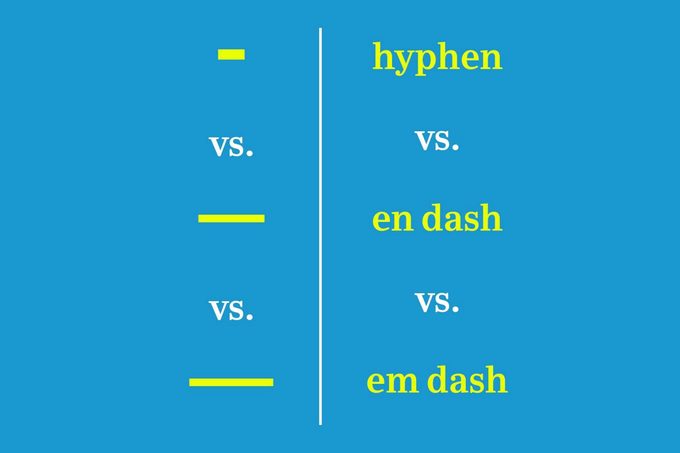Yes, there is a real difference between a hyphen vs. dash. And here's how these tiny marks can make a big difference in your writing.

This Is When to Use a Hyphen vs. Dash

When you’re writing by hand, a hyphen and a dash can look pretty similar, although the meanings differ. You might throw in a hyphen to link two well-known words or add a dash—for impact, of course. But in the digital world, there’s a clear visual difference between the two. So if you’ve ever been stumped by the whole hyphen vs. dash debate, you’re not alone. It’s one of the most common punctuation mistakes out there, and we’re here to help you avoid it.
Grammar rules can be tricky, but the difference in using a hyphen vs. dash is more straightforward than you might think. Read on to learn when—and how—to use each correctly in your writing.
Get Reader’s Digest’s Read Up newsletter for more grammar knowledge, tech, travel, cleaning, humor and fun facts all week long.
Hyphen vs. en dash vs. em dash
Grammar rules aside, the very first difference between a hyphen and a dash is their size, with a dash appearing longer than a hyphen. But let’s break down the dash into two main types: the en dash and the em dash. The latter is the longest, followed by the midsized en dash and eventually the hyphen, which is the shortest.
Here’s how they compare:
- Hyphen: –
- En dash: –
- Em dash: —
However, outside of these aesthetic differences (and the unique computer commands it takes to achieve them digitally), there are distinct grammatical intents for these punctuation marks as well. Keep reading to find out when you should use a hyphen vs. a dash.
When to use a hyphen
A hyphen is what appears when you press the button next to the zero key. There are two main instances in which you’ll use it in your writing:
- To link words: According to Merriam-Webster, a hyphen links elements in compound words. It’s what you use to create compound words like can-do or self-control as well as compound names like Lin-Manuel Miranda. You’ll use this punctuation mark to turn two words into a modifier, like a dog-friendly hotel or a alcohol-laced drink.
- To format numbers: A hyphen is also the symbol you use to write out longer numbers, such as twenty-three.
When to use a dash
Dashes (of both the em and en variety) have a totally different purpose than a hyphen. A dash indicates a significant pause or a surprising twist in a sentence. But there’s a big difference between using an en dash and an em dash.
Em dash (—)
- To mark a change in the sentence. Em dashes, usually in pairs, signal an abrupt change in the sentence structure and set off a phrase within a sentence. For instance: “The longest plane flight in the world—which I’m taking in two weeks—lasts more than 18 hours.”
- To add impact. The em dash is also useful for highlighting an element of a sentence you want to emphasize. As in: “He’s not the mastermind—I am!”
- To signal abruptly cut-off speech. An em dash can take the place of missing text in dialogue. For example: “‘Do you think he knows we’re—’ she began. ‘Shhh!’ I cut in.”
En dash (–)
- To indicate a range. The en dash is your go-to when showing a range, like 1990–2000, pages 10–15 or Monday–Friday.
- To link words. The en dash links compound adjectives when one of the adjectives is more than one word, as in a New York–London flight or World War II–era equipment.
But how is a compound word using an en dash different from a compound word using a hyphen? Keep scrolling to get to the bottom of it!
Hyphen vs. en dash
Telling the difference between a hyphen and an en dash can be surprisingly tricky. They may look alike and create compound words, but they serve different purposes. Here’s an easy way to keep them straight:
- If you’re linking two single words: Use a hyphen. For instance, if you’re linking the words five and star before the word hotel to specify a hotel with five stars, you’d use a hypen to write five-star hotel.
- If you’re linking two terms in which one term is more than one word: Use an en dash. For instance, if you’re linking the word pre and the term Civil War to indicate a time before the Civil War, you’d use an en dash to write pre-Civil War.
Don’t worry if you don’t get the distinction right away. The en dash is like the black sheep of the punctuation family, often overlooked and rarely invited to the party. It’s one of the least-known punctuation marks, but if you want to give it the recognition it deserves in your digital writing, just follow the simple steps below.
How to make a hyphen vs. dash on the keyboard
The keyboard shortcuts for a hyphen vs. dash can be just as confusing as knowing when to use each one. To save you the head-scratching, here are the quick shortcuts for typing the hyphen, en dash and em dash:
- Hyphen (-): Press the key right next to the zero on your keyboard.
- En dash (–): Press “Option” + the hyphen key on a Mac or “Alt” + “0150” on a Windows PC.
- Em dash (—): Press “Shift” + “Option” + the hyphen key on a Mac or “Alt” + “0151” on a Windows PC. In Microsoft Word, typing two hyphens in a row usually autocorrects to an em dash.
Knowing when to use a hyphen vs. dash may seem small, but it sharpens your writing instantly. With this tip in your toolkit, your sentences will be clearer and more polished every time.
Why trust us
At Reader’s Digest, we’re committed to producing high-quality content by writers with expertise and experience in their field in consultation with relevant, qualified experts. We rely on reputable primary sources, including government and professional organizations and academic institutions as well as our writers’ personal experiences where appropriate. We verify all facts and data, back them with credible sourcing and revisit them over time to ensure they remain accurate and up to date. Read more about our team, our contributors and our editorial policies.
Sources:
- Chicago Manual of Style: “Hyphens, En Dashes, Em Dashes”
- Merriam-Webster: “How to Use Em Dashes (—), En Dashes (–) and Hyphens (-)”





















